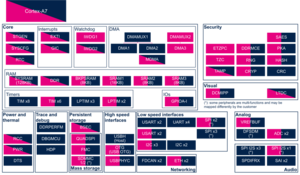1. Article purpose[edit | edit source]
The purpose of this article is to:
- briefly introduce the PWR peripheral and its main features,
- indicate the peripheral instances assignment at boot time and their assignment at runtime (including whether instances can be allocated to secure contexts),
- list the software frameworks and drivers managing the peripheral,
- explain how to configure the peripheral.
2. Peripheral overview[edit | edit source]
The PWR peripheral is used to control the device power supply configuration.
It has 6 input pins (named wakeup pins) which can be programmed to wake the system up from low power. The wakeup pins are listed with WKUP prefix in the STM32MP13 Datasheet.
These pins can be used by the Cortex®-A7 non secure (via Cortex®-A7 secure services).
The PWR peripheral provides 3 output hardware lines named PWR_ON, PWR_LP and PWR_CPU_ON:
- In STPMIC1 configuration, PWR_ON allows to select the register bank (active or low power). PWR_LP and PWR_CPU_ON are not used.
- In STPMIC1L configuration, all 3 lines are used and may control regulators state depending on STPMIC configuration.
- In the power discrete solution they drive VDDcore which feeds the Cortex®-A7 and the peripherals. They also control the DDR power supplies (VDD_DDR, VREF_DDR, VTT_DDR) and VDDCpu that feeds the porcessor.
Refer to the STM32MP13 reference manuals for the complete list of features, and to the software frameworks and drivers, introduced below, to see which features are implemented.
3. Peripheral usage[edit | edit source]
This chapter is applicable in the scope of the OpenSTLinux BSP running on the Arm® Cortex®-A processor(s), and the STM32CubeMPU Package running on the Arm® Cortex®-M processor.
3.1. Boot time assignment[edit | edit source]
3.1.1. On STM32MP13x lines  [edit | edit source]
[edit | edit source]
The PWR is closely configured together with RCC by all the boot components: the ROM code, the FSBL, the SSBL. Its configuration is carried by the device tree.
Click on ![]() to expand or collapse the legend...
to expand or collapse the legend...
Check boxes illustrate the possible peripheral allocations supported by the OpenSTLinux BSP:
- ⬚ means that the peripheral can be assigned to the given boot time context, but this configuration is not supported in OpenSTLinux BSP.
- ☐ means that the peripheral can be assigned to the given boot time context.
- ☑ means that the peripheral is assigned by default to the given boot time context and that the peripheral is mandatory for the OpenSTLinux BSP.
- ✓ is used for system peripherals that cannot be unchecked because they are hardware connected in the device.
The present chapter describes STMicroelectronics recommendations or choice of implementation. Additional possibilities might be described in STM32 MPU reference manuals.
| Domain | Peripheral | Boot time allocation | Comment | |||
|---|---|---|---|---|---|---|
| Instance | Cortex-A7 secure (ROM code) |
Cortex-A7 secure (TF-A BL2) |
Cortex-A7 nonsecure (U-Boot) | |||
| Power & Thermal | PWR | PWR | ✓ | ✓ | ||
3.2. Runtime assignment[edit | edit source]
3.2.1. On STM32MP13x lines  [edit | edit source]
[edit | edit source]
Click on ![]() to expand or collapse the legend...
to expand or collapse the legend...
Check boxes illustrate the possible peripheral allocations supported by the OpenSTLinux BSP:
- ⬚ means that the peripheral can be assigned to the given runtime context, but this configuration is not supported in OpenSTLinux BSP.
- ☐ means that the peripheral can be assigned to the given runtime context.
- ☑ means that the peripheral is assigned by default to the given runtime context and that the peripheral is mandatory for the OpenSTLinux BSP.
- ✓ is used for system peripherals that cannot be unchecked because they are hardware connected in the device.
Refer to How to assign an internal peripheral to an execution context for more information on how to assign peripherals manually or via STM32CubeMX.
The present chapter describes STMicroelectronics recommendations or choice of implementation. Additional possibilities might be described in STM32MP13 reference manuals.
| Domain | Peripheral | Runtime allocation | Comment | ||
|---|---|---|---|---|---|
| Instance | Cortex-A7 secure (OP-TEE) |
Cortex-A7 nonsecure (Linux) | |||
| Power & Thermal | PWR | PWR | ✓ | ||
4. Software frameworks and drivers[edit | edit source]
Below are listed the software frameworks and drivers managing the PWR peripheral for the embedded software components listed in the above tables.
- Linux®: power management, regulator framework with SCMI regulators
- OP-TEE:
5. How to assign and configure the peripheral[edit | edit source]
The peripheral assignment can be done via the STM32CubeMX graphical tool (and manually completed if needed).
This tool also helps to configure the peripheral:
- partial device trees (pin control and clock tree) generation for the OpenSTLinux software components,
- HAL initialization code generation for the STM32CubeMPU Package.
The configuration is applied by the firmware running in the context in which the peripheral is assigned:
- PWR wake-up pins configuration in OP-TEE
- PWR IO domains configuration in OP-TEE
- Configuration in STM32MP1 Power overview
6. How to go further[edit | edit source]
STM32MP1 Power overview shows the usage of PWR drivers in OpenSTlinux power management.
The PWR is interfaced with the hardware debug port (HDP) of the STM32MP13. This link offers the flexibility to observe the main PWR state signals on debug pins.
Please refer to STM32MP13 reference manuals for the exact list of signals that can be monitored.
